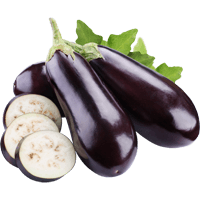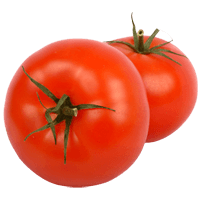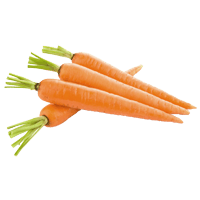Cucumber: Complete Data of Nutrients, Diets, Health Impact, & More
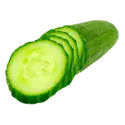
Introduction
Cucumbers are one of the most widely spread vegetables in the world. They mainly consist of water and are often associated with the feeling of refreshment; the inside temperature of a cucumber can be up to 20°F (7°C) cooler than the outside air.
In this article, we'll discuss the components of cucumbers, their health impact, diets, varieties, and more.
Table of contents
- Classification
- Nutrition
- Calories
- What Do 15 Calories or 100 Grams of Cucumber Look Like?
- Carbohydrates
- Protein
- Fats
- Vitamins
- Minerals
- Oxalates
- Phytochemicals
- Nutrient Composition Comparison Among Different Parts of Cucumber
- Variations in Cucumber Bitterness Depending on Fruit Maturity, Season, and Other Factors
- Comparison to Similar Foods
- Health Impact
- Cooking
- Storing, Keeping, and Conservation
- Cucumbers in Diets
- Cucumber Varieties
- Origin and History
- Outbreaks
- Consumption and Production
- References
Classification
Cucumbers (Cucumis sativus) are creeping vine plants that belong to the Cucumis genus and the Cucurbitaceae family, also known as the gourd family, which includes squashes, melons, and pumpkins.
Cucumbers grow as creeping vines up supporting frames or trellises. The large leaves on these vines provide a canopy over the growing fruit. From a botanical point of view, a cucumber is not a vegetable but a false berry. It is classified as a pepo: a modified berry with a thick outer rind and no internal divisions, just like a watermelon. However, cucumbers are commonly cooked and used as vegetables.
Nutrition
Cucumbers are known for consisting of 95% water, but what comprises the other 5%?
The nutritional values and infographics in this article apply to raw cucumbers with peel.
While the average serving size of a cucumber is half a cup in slices (equal to 52g), most information is provided for 100g of the vegetable.
Macronutrients chart
Calories
Cucumbers are a low-calorie food. A 100g of raw cucumbers, with peel, contains only 15 calories. Cucumbers without peel contain even fewer calories, with 12 calories per 100g.
What Do 15 Calories or 100 Grams of Cucumber Look Like?
The image below shows that half a cucumber makes up 100 grams, equivalent to 15 calories. This implies that a whole cucumber, assuming it weighs approximately 200 grams, would have a doubled calorie content of about 30 calories. It's essential to note that these values may vary based on the size and type of the cucumber.
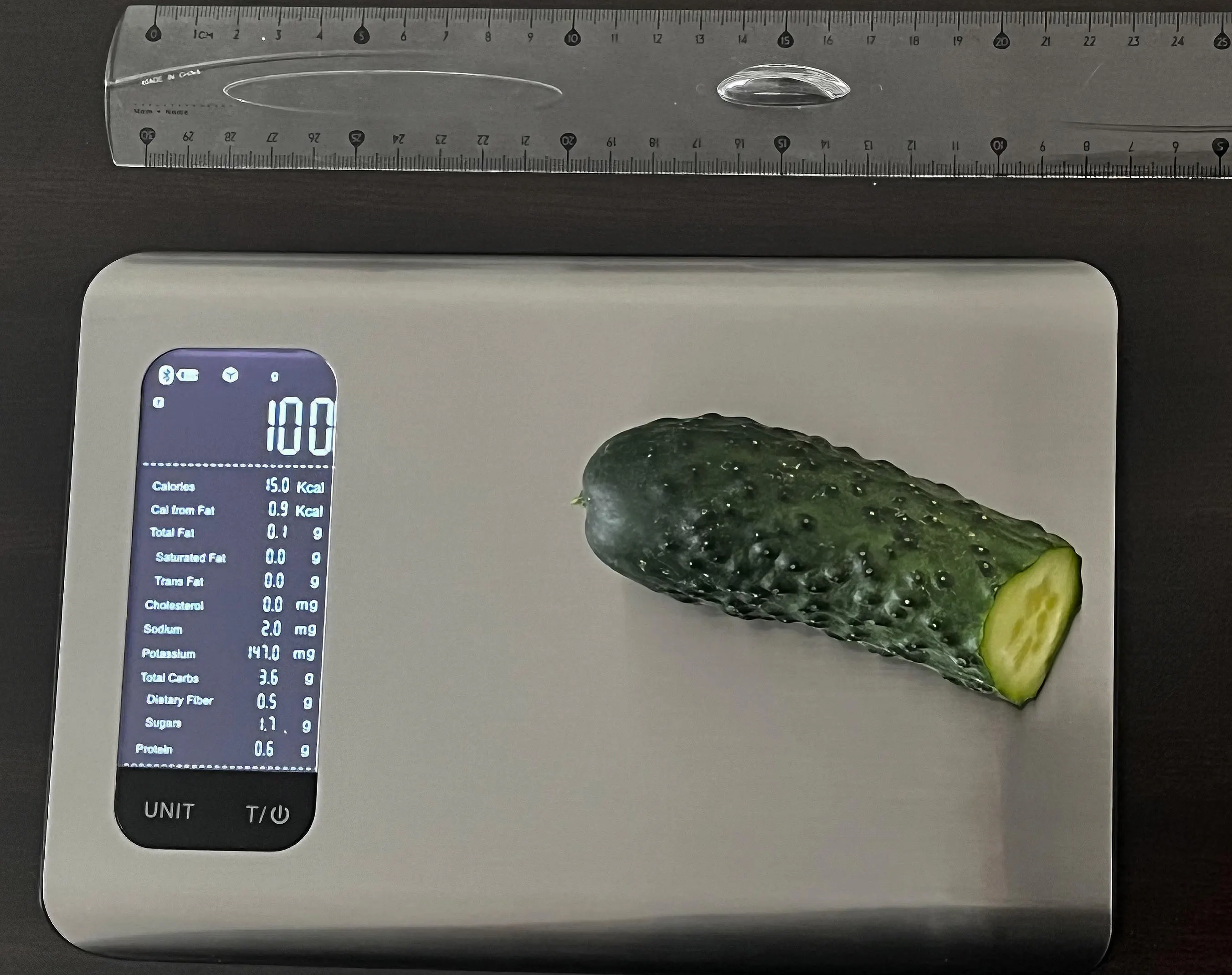
Carbohydrates
The predominant macronutrients in cucumbers are carbohydrates. 100g of cucumbers with peel contains 3.63g of carbs.
Net Carbs
Cucumbers are almost equally high in starch, fructose, and glucose. They also contain some amounts of maltose and sucrose and are absent in lactose and galactose.
Carbohydrate type breakdown
Fiber
100g of cucumbers with peel contains 0.5g of dietary fiber. According to studies, most of the cucumber’s dietary fiber is insoluble. The main function of insoluble fiber in the organism is to promote bowel regularity and relieve constipation (1, 2).
Protein
Cucumbers are low in protein, containing only 1 gram of protein per serving; however, they do contain, in small amounts, all essential amino acids. Cucumbers contain the highest amounts of tryptophan, threonine, and isoleucine, of the essential amino acids.
Protein quality breakdown
Fats
Cucumbers are naturally very low in fat: less than 1g per serving. They also do not contain trans fats and cholesterol.
Vitamins
Cucumbers, like most fruits and vegetables, contain some principal vitamins. They are mainly rich only in vitamin K.
One large cucumber (approximately 300g) may cover 41% of the recommended daily value of vitamin K. Vitamin K is essential for the formation of several clotting factors, the lack of which would cause bleeding (3).
Cucumbers also contain some amounts of most B complex vitamins and vitamins C, A, and E.
They completely lack vitamin D and vitamin B12.
Vitamin coverage chart
Minerals
Cucumbers contain low amounts of many minerals. They are the highest in calcium, manganese, and potassium. Magnesium, copper, zinc, iron, phosphorus, choline, and selenium are also present in small amounts.
Cucumbers are naturally very low in sodium, falling into the top 4% of foods low in sodium.
Mineral coverage chart
Oxalates
Oxalates (oxalic acids) are compounds found in many vegetables, fruits, grains, and nuts. Even though they are mostly harmless, they may increase the risk of calcium oxalate kidney stone formation in some people.
Cucumber contains 4mg of oxalates per 100g, making it a low-oxalate food (4).
Phytochemicals
Cucumbers are rich in phytochemicals, biologically active compounds produced by plants. Most of them benefit human health and decrease the risk of various diseases.
Various phytochemicals show antibacterial, antifungal, anticancer, hypoglycemic, and hypolipidemic activity and protective activity against ulcerative colitis (5).
Cucumbers contain polyphenols (glycosides, lignans, and flavonoids), terpenoids (cucurbitacins, saponins, and steroids), resins, alkaloids, and tannins (6).
Polyphenols
Polyphenols found in cucumbers include cardiac glycosides, lignans, and flavonoids (vitexin, orientin, apigenin, quercetin, kaempferol, etc.) (7).
According to a study, semi-ripe cucumbers contain 2 times more polyphenols than ripe cucumbers (8).
As the name suggests, cardiac glycosides’ target organ is the heart; they are studied to improve the renin-angiotensin system axis and, thus, beneficially affect the heart (9).
Lignans show anti-inflammatory, antioxidant, and antitumor activities and may decrease the risk of heart disease (10).
Similarly, flavonoids show anticancer, antioxidant, anti-inflammatory, antiviral, neuroprotective, and cardioprotective activity (11).
Terpenoids
One of the primary cucumber terpenes, cucurbitacin, is isolated from the Cucurbitaceae family members, such as cucumbers, pumpkins, and gourds (12).
The role of cucurbitacins in human health is discussed in the “Health Impact” section.
Nutrient Composition Comparison Among Different Parts of Cucumber
Scientists from the Chemistry Department of Ekiti State University separated the cucumber peel, pump, and seed to see the macronutrient and mineral differences (13). In the kitchen, It may help decide whether to remove the skin or seeds or keep them before consumption.
Protein and fat were the highest in cucumber peel, followed by seed and pulp. Fiber was also the highest in peel, followed by pulp, leaving the seed at the end. The carbohydrate content was the highest in cucumber pulp, followed by cucumber seed and peel.
| Cucumber part | The highest concentrations of minerals |
| Seed | Sodium, potassium, calcium, zinc, iron |
| Pulp | Magnesium, copper, manganese |
| Peel | The peel had the least mineral concentrations |
Variations in Cucumber Bitterness Depending on Fruit Maturity, Season, and Other Factors
Cucurbitacins, mainly cucurbitacin C, are responsible for the bitterness of the foods of the Cucurbitaceae family. Elaterase is the enzyme that breaks down the cucurbitacins, making the cucumbers less bitter. Elaterase changes; thus, the amount of bitterness may vary from year to year, location to location, and due to factors such as maturation and growing conditions.
Maturation - Mature cucumbers are naturally less bitter as cucurbitacins are hydrolyzed to their non-bitter principles by elaterase during maturing.
Growing conditions - Cool temperatures can enhance bitterness, but fertilization practices, plant spacing, and irrigation frequency have exhibited a little consistent effect on the number of bitter cucumbers produced.
Nitrogen concentrations - High levels of total nitrogens may also enhance the bitterness of cucumbers.
To avoid bitterness, it is recommended not to grow cucumbers in cool or shaded locations and to provide ample water and nutrients for the fruit to grow. Cutting the stem end will likely reduce bitterness, as cucurbitacins are more likely to concentrate in the stem and under the peel (14, 15).
Glycemic Index
Generally, the glycemic index of vegetables tends to be low.
The glycemic index of a cucumber is calculated to be 21±6, which makes it a low glycemic index food. Cucumbers also have a low glycemic load of 1.5 (16).
Acidity
Cucumber is one of the most alkaline foods due to triterpenes. Because of this quality, it may also help regulate diseases that involve the immune system, as well as express anti-inflammatory qualities (17).
The acidity of cucumbers based on the potential renal acid load (PRAL) is -2.4, making it alkaline-forming.
Comparison to Similar Foods
In this section, we will compare cucumbers to similar vegetables or those frequently compared to them.
Cucumber vs. Eggplant - Eggplants are significantly richer in dietary fiber. They are also slightly higher in protein and fat, whereas cucumbers are slightly lower in calories and sugar. Eggplants are slightly richer in B complex vitamins, manganese, and copper, whereas cucumbers are significantly richer in vitamin K.
Cucumber vs. Zucchini - Zucchini is slightly higher in protein, fat, and fiber, whereas cucumber is lower in sugars. Zucchini is also richer in most minerals and vitamins, predominantly C and B6.
Cucumber vs. Carrot - Carrots are denser than cucumbers; consequently, they are higher in all macronutrients, vitamins, and minerals. Carrots are one of the primary sources of vitamin A.
Health Impact
Cardiovascular Health
Antioxidant Effects
Oxidative stress is one of the main mechanisms that lie in the development of cardiovascular health issues. Cucumbers showed a good amount of total phenolic and flavonoid content and carotenoids, tannins, and lycopene, expressing significant antioxidant activity (18).
Studies have shown that yellow cucumbers express stronger antioxidant qualities than green and white cucumbers (19).
Hypotensive Effects
People with high blood pressure are advised to avoid foods high in salt. Luckily, cucumbers contain very low amounts of sodium.
One research has concluded that cucumber juice lowered blood pressure in elderly people, decreasing both systolic and diastolic blood pressures. This effect may be due to the cucumber’s ability to decrease the amount of fluid circulating in the bloodstream, reducing the heart’s workload (20).
Cucumber also contains calcium, magnesium, potassium, and fiber, the basis of the DASH diet, sponsored by the National Institutes of Health, to decrease blood pressure.
Antiartherosclerotic Effects
Atherosclerosis is the leading cause of heart attacks, strokes, and peripheral vascular disease. It is the buildup of fats, cholesterol, and other compounds in the walls of the body’s blood vessels. Cucurbitacins have been studied to have a therapeutic role in atherosclerosis by modifying lipoproteins (21).
Diabetes
Hypoglycemic Effects
Cucumbers have been investigated for their hypoglycemic and hypolipidemic effects. One study showed that cucumber extracts decrease blood glucose, low-density lipoprotein, and cholesterol levels in alloxan-induced diabetic rats (22).
Cucurbitacins have also expressed hypoglycemic, antihyperglycemic, and antidiabetic qualities. The underlying mechanism for the antihyperglycemic effect is possibly the stimulation of insulin release and regulation of the liver’s glucose metabolism (23).
Another study showed that consuming an increased dose of cucumbers demonstrates significant hypoglycemic, antidiabetic, as well as antihypertensive effects (23).
Cucumbers can also efficiently decrease oxidative and carbonyl stress, protecting diabetic patients from complications (24).
A study has concluded that adding yogurt and pickled cucumbers to a high glycemic index meal, such as white bread, significantly lowered the meal’s postprandial glycemic and insulinemic response (25).
Antiobesity effects
Foods with high water and fiber content have been proven to benefit weight loss. Cucumbers consist of 95% water and are rich in fiber.
A study has concluded that cucumber has greatly assisted weight loss in female albino rats (26).
Cancer
Cucumbers have been researched in several studies for their potential antitumor activities.
Cucurbitacin I, found in cucumbers, has been demonstrated to possess antitumor qualities against human breast carcinomas by inhibiting malignant signaling pathways, playing a potential role in developing future anticancer drugs (27).
Other cucurbitacin groups have been found to possess certain antiproliferative effects against laryngeal, pancreatic, prostate, and lung cancers by inhibiting tumor angiogenesis and certain enzymes in cancer cell lines (21, 28).
Cucumber flowers, specifically the ethyl acetate fraction of the cucumber flowers, have been proven to have significant anticancer effects on liver cancer by inducing apoptosis in human cancer cell lines (29).
Antimicrobial Effects
One research has shown the phosphate buffer solution of Cucumis sativus extracts to have antimicrobial activity, specifically against gram-positive Staphylococcus Aureus and gram-negative Pseudomonas Aeruginosa (30).
Another study examined the antimicrobial effects of cucumber seed extracts and their effectiveness against Serratiamarcescens, E. coli, Streptococcus thermophilus, Fusarium oxysporum, and Trichoderma reesei (18).
The ethanol extract of Cucumis sativus has been demonstrated to possess some antifungal activities against Aspergillus niger, Candida albicans, and other fungi (31).
Allergy
Cucumber allergies are not that common, but, like most food allergies, they can lead to severe issues if ignored.
People with certain allergies have a higher possibility of being allergic to cucumbers. One of these allergies includes hypersensitivity to ragweed (32). Cross-reactivity between cucumbers and timothy grass, rye, and ambrosia has also been found (33).
The gourd family, which includes squash, pumpkin, zucchini, watermelon, and others, may contain the same compounds that cause hypersensitization in cucumbers.
Cucumbers contain a natural acid called salicylate, a major ingredient in Aspirin; therefore, people with an allergy to Aspirin may also need to avoid cucumbers.
The symptoms of a cucumber allergy can vary from mild to severe. These can include oral allergy syndrome (itching, tingling, redness, or swelling of the mouth area), oropharyngeal symptoms, watery eyes, asthma, nausea, diarrhea, and, in rare cases, anaphylaxis.
A study has shown that a cucumber allergy following primary sensitization to pollens other than birch may be effectively reduced by pollen-specific injection immunotherapy (34).
Cooking
Slicing cucumbers are often used fresh in salads or eaten raw, whereas pickling cucumbers are fermented.
Safety measures must be applied to avoid foodborne illnesses when fermenting or pickling cucumbers. The recipe portions must be followed, and avoiding homemade vinegar or vinegar with unknown acidity is advised. The mixed product must have enough acidity to avoid the growth of Clostridium botulinum bacteria, which can cause severe food poisoning (35).
Cucumbers can also be sauteed, fried, or used in soups.
Storing, Keeping, and Conservation
The correct storage of a cucumber is 10 to 14 days at 50 ° F (10 ° C) to 55 ° F (13 ° C) with 95% humidity (36). Cucumbers should not be left out at room temperature for too long as it may cause them to wilt and become limp.
Cucumbers in Diets
| Keto | One half-cup serving of cucumbers contains only 3g of net carbs, so cucumbers fit into a keto diet. |
| DASH | Cucumbers are an excellent choice for people on the DASH diet since they are low in sodium but high in calcium, magnesium, potassium, and fiber. Cucumbers have been studied to have hypotensive effects (20). |
| Atkins | Cucumbers are included in the list of 8 recommended low-carb vegetables. During Atkins 20 Phase 1 of the program, it is encouraged to eat 12 to 15 grams of carbs from vegetables per day. This can be several servings of cucumbers. You are encouraged to eat fresh, low-carb vegetables in every phase of the diet (37). |
| Mediterranean | Fruits and vegetables are an essential part of the Mediterranean diet. Cucumbers definitely fit this diet. |
| Paleo | You can add cucumbers to almost any meal on the paleo diet (38). |
| Vegan/ Vegetarian/ Pescetarian | Cucumbers are plant-based; therefore, they fit vegan, vegetarian, and pescetarian diets. |
| Dukan | You cannot eat cucumbers in the first (Attack) phase; however, pickles are allowed, only as gherkins and still in moderation since they are high-salt foods. The same goes for the second (Cruise) phase. You can add fresh cucumbers to your diet in the third (Consolidation) and fourth (Stabilisation) phases (39). |
| Intermittent Fasting | Cucumbers are not allowed in the fasting period but can be freely used during the eating periods. However, some people choose to eat cucumbers during their fast since they are low in calories and a good source of hydration. |
| Low Fat & Low Calorie | In a 100g serving, cucumbers contain less than 1g of fats and 15 calories. You can freely use cucumbers on low-fat and low-calorie diets. |
| Low Carb | Cucumbers only contain 4g of carbohydrates per 100g. They fit in a low-carb diet. |
| Anti Inflammatory | Cucumbers are rich in phytonutrients that potentially possess anti-inflammatory effects. In addition, cucumbers are alkaline foods (17). For these reasons, they fit into the anti-inflammatory diet. |
| BRAT | Cucumbers can be used in the BRAT diet since they are a great hydration source and are easy to digest. |
| Low FODMAP | Cucumbers are low in FODMAPs and considered safe for people with IBS and functional abdominal distension. |
Cucumber Varieties
Over the years, the domestication of cucumbers has led to the formation of numerous cucumber cultivars. Cucumber varieties differ by many characteristics, such as size and shape, color, spine type (coarse or fine), the color of the spine (black or white), thickness, or texture of the skin.
Based on production, there are two main varieties of cucumbers: greenhouse and outdoors.
Based on consumption, cucumbers are often divided into three large groups: slicing, pickling, and burpless.
Slicing
Slicing cucumbers are produced for fresh consumption and are often used in salads. They usually have thicker rinds, making them less prone to damage during harvest and transportation, and they are larger than pickling cucumbers, about 8-9 inches (20-23 cm). Slicing cucumbers can be both monoecious (having female and male reproductive organs) and gynoecious (producing only female flowers).
American
American cucumbers are a cultivar of slicing cucumbers. They are quite thick, with a bulge in the middle, and contain many large seeds. They also have smooth skin and are waxed after harvest to extend their shelf life and better retain moisture.
Pickling
These cucumbers are processed not for fresh consumption but for processing into pickles, although they can be eaten fresh. Pickling cucumbers are much smaller, about 3-7 inches (8-18 cm), and have thin and warty skins, larger seeds, and a lighter green color. They can have both black and white spines; however, white-spined cucumbers take longer to grow and later retain their color and firmness for longer. The white-spine varieties are more often grown and used in warm temperatures, whereas black-spined cultivars are found in cooler climates (40).
Gherkin
The word gherkin often refers to fermented or pickled cucumbers. The gherkin pickles are small, 1-5 inches (2.5 to 13cm), have bumpy skin and are the most commonly pickled cucumbers.
West Indian gherkins or maroon cucumbers are closely related to the common cucumber and its gherkin cultivar. However, they are much smaller than most pickling cucumbers and have distinctive fruit stems and short spikes. Their color ranges from yellow to green, and they can also be pickled.
Kirby
Kirby cucumbers are small and often have an irregular shape. They also have thin and bumpy skin and few seeds. Their flavor can range from mild to sour.
Burpless
Burpless cucumbers are also named seedless cucumbers, and following the names, they have very few seeds and smooth skin. They are usually even bigger in size than slicing cucumbers. Burpless cucumbers often have a mild taste since they do not contain as much of the compound called cucurbitacin, giving them their bitter taste.
English
English cucumbers are often called seedless, greenhouse, or hothouse cucumbers. They have thin, ridged skin and underdeveloped seeds. They are usually 10 to 12 inches (25 to 30cm) long and have a mild to sweet flavor.
Japanese
Japanese cucumbers are usually seedless, burpless, slender, and long, sometimes growing up to 20 inches (50cm). However, some varieties of Japanese cucumbers can be smaller and have bumpy skin.
Japanese cucumbers are never bitter and often have a melon-like taste.
Other
Lemon
As the name suggests, lemon cucumber resembles a lemon with its round shape with a somewhat protruding end, small size, and golden yellow color. However, lemon cucumbers do not taste like actual lemons; they have a mild or slightly sweet taste. They also have much thinner and more tender skin.
Apple
Much like lemon cucumbers, apple cucumbers resemble apples by their appearance. It has a round shape, a white or light green color, a crisp texture, and a mild, sweet taste.
Armenian
The Armenian cucumber (Cucumis melo var. flexuosus), also known as snake cucumber, is not a cucumber but a muskmelon cultivar. However, it looks and tastes like cucumber. It is light green and thin, with bumpless skin that has indents along its length.
Origin and History
Cucumbers originated in South Asia, more specifically in some regions of India, around 3000 years ago, with the probable ancestor being Cucumis hardwickii (Royle), also often called wild cucumber. Cucums from India were brought to Greece, Italy, and later to China. Records have confirmed the cultivation of cucumbers in France by the 9th century, in England by the 14th century, and in North America by the mid-16th century (41).
Outbreaks
From 1998 to 2013, ten outbreaks were associated with cucumbers in the United States. During these outbreaks, 483 people became ill, and eight were hospitalized (40).
In 2013, an outbreak of Salmonella in the United States was associated with cucumbers imported from Mexico. This outbreak caused 84 people to be infected, 28% of which were hospitalized. No cases were fatal (42).
Another severe outbreak in the United States took place in 2015. This time, the outbreak was associated with a different salmonella serotype. During this, 907 people were infected, of which 204 were hospitalized, with six fatal outcomes. Once again, the contamination was associated with distributors and not domestically produced cucumbers (40).
Consumption and Production
Cucumber plants naturally thrive in both temperate and tropical environments and, for this reason, have been widely cultivated worldwide. Nowadays, China is by far the world’s largest producer of cucumbers, with over 54 million tons of total production. Turkey, Iran, the Russian Federation, Ukraine, and Spain are the next four highest producers, followed by the United States, Mexico, and Egypt (43).
From 1995 to 2005, there was a 15% growth in the consumption of fresh cucumbers - an approximately 1 pound per capita increase. As of 2012, Americans consumed an average of 6.5 pounds of fresh cucumbers per person. Regarding pickled cucumbers, Americans annually consume around 9 to 11 pounds per person. According to the 2006–2007 FoodNet Atlas of Exposures, 46.9% of the survey cohort reported eating cucumbers within the past seven days (40).
References
- https://www.ncbi.nlm.nih.gov/books/NBK326737/
- https://www.ncbi.nlm.nih.gov/pmc/articles/PMC3614039/table/Tab2/
- https://medlineplus.gov/ency/article/002407.htm
- https://www.researchgate.net/publication/280642641
- https://www.researchgate.net/publication/350152210
- https://academicjournals.org/journal/AJB/article-full-text/D0F282A58745
- https://pubmed.ncbi.nlm.nih.gov/23098877
- https://www.scielo.cl/pdf/chiljar/v81n2/0718-5839-chiljar-81-02-220.pdf
- https://pubmed.ncbi.nlm.nih.gov/27780131/
- https://www.ncbi.nlm.nih.gov/pmc/articles/PMC6429205/
- https://www.ncbi.nlm.nih.gov/pmc/articles/PMC7697716
- https://www.acs.org/molecule-of-the-week/archive/c/cucurbitacins.html#
- https://www.scirp.org/html/2-2311030_95182.htm
- https://vric.ucdavis.edu/pdf/cucumber.pdf
- https://www.sciencedirect.com/science/article/abs/pii/S0367326X12002791
- Glycemic Index of Some Traditional Fruits in Jamaica
- https://www.academia.edu/28634174/
- https://www.researchgate.net/publication/328766087
- https://www.semanticscholar.org/paper/4f306f21255a4224a74a4f68d09b8a979afa27a9
- https://www.researchgate.net/publication/330442483
- https://www.ncbi.nlm.nih.gov/pmc/articles/PMC4441156/
- https://www.banglajol.info/index.php/JSR/article/view/10252
- https://www.researchgate.net/publication/335972955
- https://www.ncbi.nlm.nih.gov/pmc/articles/PMC4916550/
- https://www.researchgate.net/publication/11889493
- http://www.herdin.ph/index.php/herdin-home?view=research&cid=62797
- https://pubmed.ncbi.nlm.nih.gov/12649187/
- https://cancerres.aacrjournals.org/content/69/14/5876
- https://www.researchgate.net/publication/303121869
- https://www.researchgate.net/publication/288228852
- https://www.academia.edu/36194415/
- https://pubmed.ncbi.nlm.nih.gov/3584742/
- Pollen-associated food allergies
- https://www.researchgate.net/publication/12521050
- https://bookstore.ksre.ksu.edu/pubs/mf1184.pdf
- https://ppod.foodrisk.org/transports/search/cucumber
- List of 8 Low Carb Vegetables & Fruits
- https://www.paleodiet.co.uk/cucumbers
- https://thedukandiet.info/dukan-diet-food-list/cucumber-dukan-diet/
- https://fsi.colostate.edu/cucumbers/
- https://www.researchgate.net/publication/26364541
- https://www.cdc.gov/salmonella/saintpaul-04-13/index.html
- https://www.tridge.com/intelligences/cucumber/production
Top nutrition facts for Cucumber

| Calories ⓘ Calories for selected serving | 15 kcal |
|
Glycemic index ⓘ
Source:
Check out our Glycemic index chart page for the full list.
|
21 (low) |
| Net Carbs ⓘ Net Carbs = Total Carbohydrates – Fiber – Sugar Alcohols | 3 grams |
| Default serving size ⓘ Serving sizes are mostly taken from FDA's Reference Amounts Customarily Consumed (RACCs) | 0.5 cup slices (52 grams) |
| Acidity (Based on PRAL) ⓘ PRAL (Potential renal acid load) is calculated using a formula. On the PRAL scale the higher the positive value, the more is the acidifying effect on the body. The lower the negative value, the higher the alkalinity of the food. 0 is neutral. | -2.4 (alkaline) |
| Oxalates ⓘ https://www.researchgate.net/publication/280642641 | 4 mg |
Cucumber calories (kcal)
| Calories for different serving sizes of cucumber | Calories | Weight |
|---|---|---|
| Calories in 100 grams | 15 | |
| Calories in 0.5 cup slices | 8 | 52 g |
Extra Nutrition facts for Cucumber
| Diabetes Index ⓘ our custom index | 12 |
Cucumber Glycemic index (GI)
Mineral chart - relative view
Vitamin chart - relative view
Fat type information
Fiber content ratio for Cucumber
All nutrients for Cucumber per 100g
| Nutrient | Value | DV% | In TOP % of foods | Comparison |
| Vitamin A | 5µg | 1% | 57% | |
| Calories | 15kcal | 1% | 98% |
3.1 times less than Orange
|
| Protein | 0.65g | 2% | 89% |
4.3 times less than Broccoli
|
| Fats | 0.11g | 0% | 91% |
302.8 times less than Cheese
|
| Vitamin C | 2.8mg | 3% | 34% |
18.9 times less than Lemon
|
| Net carbs | 3.1g | N/A | 62% |
17.3 times less than Chocolate
|
| Carbs | 3.6g | 1% | 64% |
7.8 times less than Rice
|
| Cholesterol | 0mg | 0% | 100% |
N/A
|
| Vitamin D | 0µg | 0% | 100% |
N/A
|
| Magnesium | 13mg | 3% | 77% |
10.8 times less than Almonds
|
| Calcium | 16mg | 2% | 61% |
7.8 times less than Milk
|
| Potassium | 147mg | 4% | 71% |
Equal to Cucumber
|
| Iron | 0.28mg | 4% | 86% |
9.3 times less than Beef broiled
|
| Sugar | 1.7g | N/A | 61% |
5.4 times less than Coca-Cola
|
| Fiber | 0.5g | 2% | 56% |
4.8 times less than Orange
|
| Copper | 0.04mg | 5% | 84% |
3.5 times less than Shiitake
|
| Zinc | 0.2mg | 2% | 85% |
31.6 times less than Beef broiled
|
| Starch | 0.83g | 0% | 96% |
18.4 times less than Potato
|
| Phosphorus | 24mg | 3% | 87% |
7.6 times less than Chicken meat
|
| Sodium | 2mg | 0% | 96% |
245 times less than White bread
|
| Vitamin E | 0.03mg | 0% | 92% |
48.7 times less than Kiwi
|
| Selenium | 0.3µg | 1% | 92% | |
| Manganese | 0.08mg | 3% | 63% | |
| Vitamin B1 | 0.03mg | 2% | 84% |
9.9 times less than Pea raw
|
| Vitamin B2 | 0.03mg | 3% | 86% |
3.9 times less than Avocado
|
| Vitamin B3 | 0.1mg | 1% | 92% |
97.7 times less than Turkey meat
|
| Vitamin B5 | 0.26mg | 5% | 77% |
4.4 times less than Sunflower seeds
|
| Vitamin B6 | 0.04mg | 3% | 83% |
3 times less than Oats
|
| Vitamin B12 | 0µg | 0% | 100% |
N/A
|
| Vitamin K | 16µg | 14% | 48% |
6.2 times less than Broccoli
|
| Folate | 7µg | 2% | 72% |
8.7 times less than Brussels sprouts
|
| Trans fat | 0g | N/A | 100% |
N/A
|
| Saturated fat | 0.04g | 0% | 88% |
159.3 times less than Beef broiled
|
| Choline | 6mg | 1% | 91% | |
| Monounsaturated fat | 0.01g | N/A | 94% |
1959.8 times less than Avocado
|
| Polyunsaturated fat | 0.03g | N/A | 92% |
1474.2 times less than Walnut
|
| Tryptophan | 0.01mg | 0% | 97% |
61 times less than Chicken meat
|
| Threonine | 0.02mg | 0% | 97% |
37.9 times less than Beef broiled
|
| Isoleucine | 0.02mg | 0% | 97% |
43.5 times less than Salmon raw
|
| Leucine | 0.03mg | 0% | 97% |
83.8 times less than Tuna Bluefin
|
| Lysine | 0.03mg | 0% | 97% |
15.6 times less than Tofu
|
| Methionine | 0.01mg | 0% | 97% |
16 times less than Quinoa
|
| Phenylalanine | 0.02mg | 0% | 97% |
35.2 times less than Egg
|
| Valine | 0.02mg | 0% | 97% |
92.2 times less than Soybean raw
|
| Histidine | 0.01mg | 0% | 97% |
74.9 times less than Turkey meat
|
| Fructose | 0.87g | 1% | 87% |
6.8 times less than Apple
|
| Caffeine | 0mg | 0% | 100% | |
| Omega-3 - EPA | 0g | N/A | 100% |
N/A
|
| Omega-3 - DHA | 0g | N/A | 100% |
N/A
|
| Omega-3 - DPA | 0g | N/A | 100% |
N/A
|
| Omega-6 - Eicosadienoic acid | 0g | N/A | 100% |
Check out similar food or compare with current
NUTRITION FACTS LABEL
Serving Size ______________
Health checks
Cucumber nutrition infographic
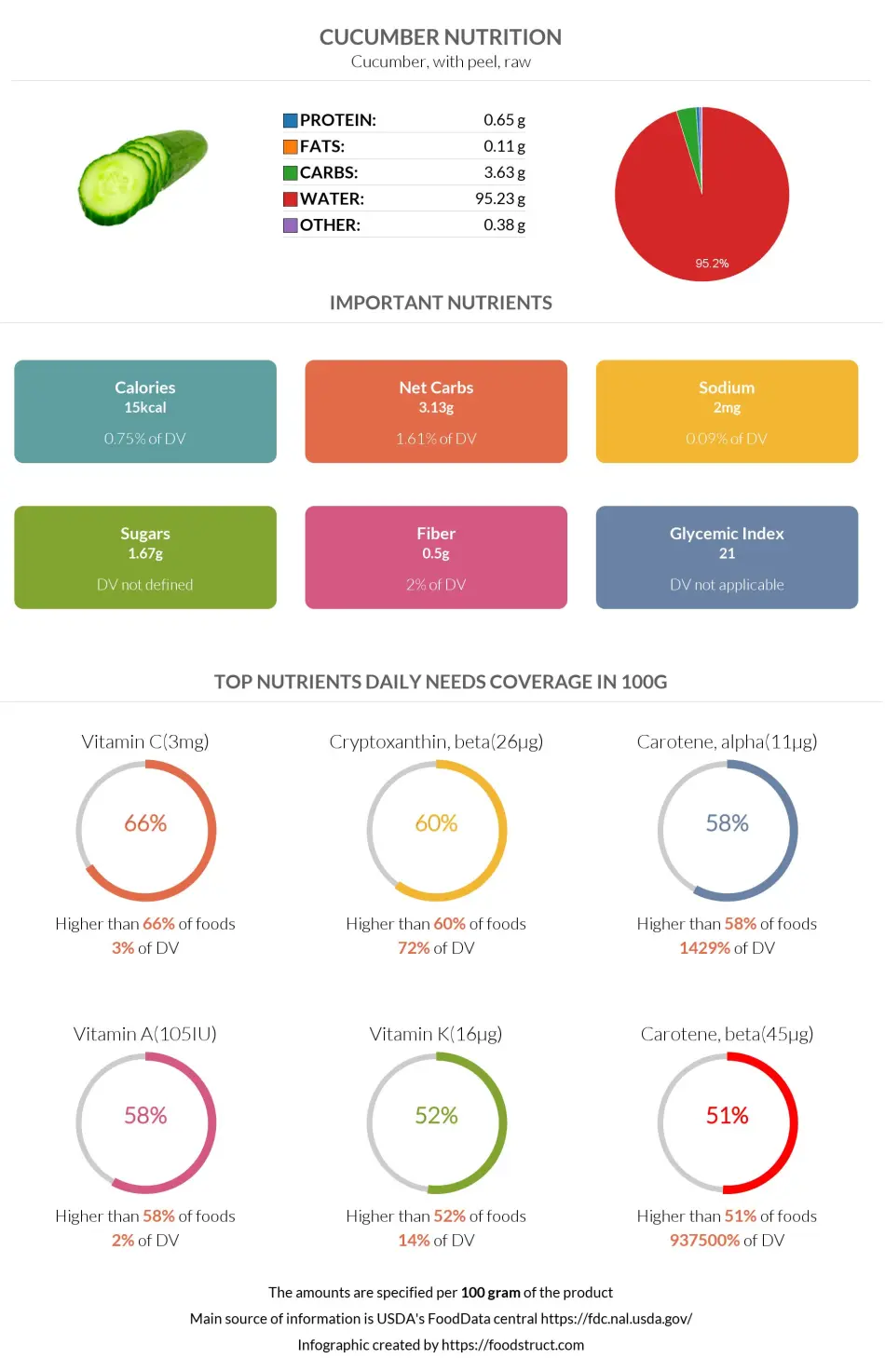
References
All the values for which the sources are not specified explicitly are taken from FDA’s Food Central. The exact link to the food presented on this page can be found below.

